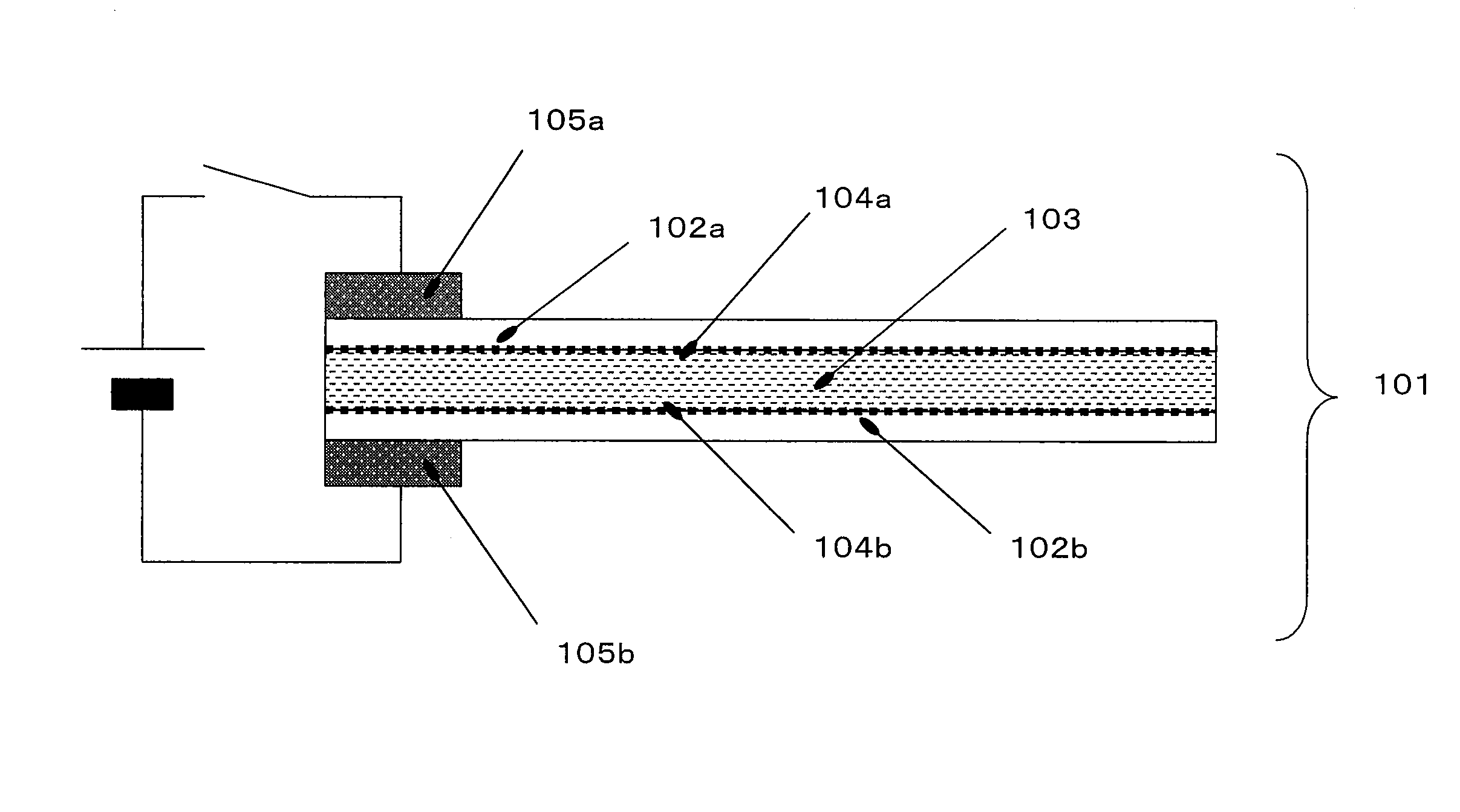Electrically conductive polymer actuator, and method for manufacturing the same
a technology of electric conductive polymer and actuator, which is applied in the direction of generator/motor, machine/engine, device material selection, etc., can solve the problem of just providing low adhesive properties to each other
- Summary
- Abstract
- Description
- Claims
- Application Information
AI Technical Summary
Benefits of technology
Problems solved by technology
Method used
Image
Examples
example 1
Production of Electrically Conductive Polymer Membrane in which Second Organic Polymer is Embedded in the State Being Dispersed
[0061]On a slide glass subjected to a treatment with oxygen plasma after washing with acetone was added dropwise a predetermined amount of an aqueous dispersion liquid (manufactured by H. C. Starck GmbH, trade name: Baytron® PH500) of a mixture of PSS and PEDOT with which 5% by weight of dimethyl sulfoxide (DMSO) and 0.1% by weight of a vinylidene fluoride-hexafluoropropylene copolymer [P(VDF / HFP)] were mixed. Since the specific gravity of P(VDF / HFP) is smaller than that of aqueous dispersion liquid of the mixture of PSS and PEDOT, P(VDF / HFP) was raised to the upper part of the mixed liquid. Thereafter, the solvent was volatilized by air drying at a room temperature, whereby an electrically conductive polymer membrane was formed on the slide glass, in which PVP was embedded in the state being dispersed. Finally, the electrically conductive polymer membrane w...
example 2
Production of Electrically Conductive Polymer Membrane in which Second Organic Polymer is Embedded in the State Being Dispersed
[0072]On a silicon substrate subjected to a treatment with oxygen plasma after washing with acetone was added dropwise a predetermined amount of an aqueous dispersion liquid (manufactured by H. C. Starck GmbH, trade name: Baytron® PH500) of a mixture of PSS and PEDOT with which 5% by weight of N-methylpyrrolidone (NMP) was mixed. Before this membrane was dried, a vinylidene fluoride / hexafluoropropylene copolymer [P(VDF / HFP)] was sprayed on the surface in an amount of 1% by weight of the aqueous dispersion liquid of the mixture of PSS and PEDOT. Thereafter, the solvent was volatilized by air drying at a room temperature, whereby an electrically conductive polymer membrane was formed on the silicon substrate, in which P(VDF / HFP) was embedded in the state being dispersed.
[0073]Finally, the silicon substrate was immersed in 50% by volume of an aqueous potassium ...
example 3
[0083]A bendable electrically conductive polymer actuator was produced in a similar manner to Example 1 except that the vinylidene fluoride / hexafluoropropylene copolymer [P(VDF / HFP)] was mixed in an amount of 0.5, 1, 5, 10, or 20% by weight. When a voltage of ±1.0 V was applied to these actuators, the bending motion was effected in response to the applied voltage without causing detachment at the electrolyte ion gel-electrically conductive polymer membrane boundary surface. Thus, these actuators could provide stable bending motion even though they were continuously driven for a long period of time, similarly to Examples 1 and 2. To the contrary, when the dispersion liquid in which the vinylidene fluoride / hexafluoropropylene copolymer [P(VDF / HFP)] had been dissolved in an amount of 20% by weight was used, the membrane was so fragile that a bendable electrically conductive polymer actuator could not be produced when a similar manner to that in Example 1 was employed. (Table 3)
[0084]
TA...
PUM
| Property | Measurement | Unit |
|---|---|---|
| electric conductivity | aaaaa | aaaaa |
| thickness | aaaaa | aaaaa |
| size | aaaaa | aaaaa |
Abstract
Description
Claims
Application Information
 Login to View More
Login to View More - R&D
- Intellectual Property
- Life Sciences
- Materials
- Tech Scout
- Unparalleled Data Quality
- Higher Quality Content
- 60% Fewer Hallucinations
Browse by: Latest US Patents, China's latest patents, Technical Efficacy Thesaurus, Application Domain, Technology Topic, Popular Technical Reports.
© 2025 PatSnap. All rights reserved.Legal|Privacy policy|Modern Slavery Act Transparency Statement|Sitemap|About US| Contact US: help@patsnap.com



